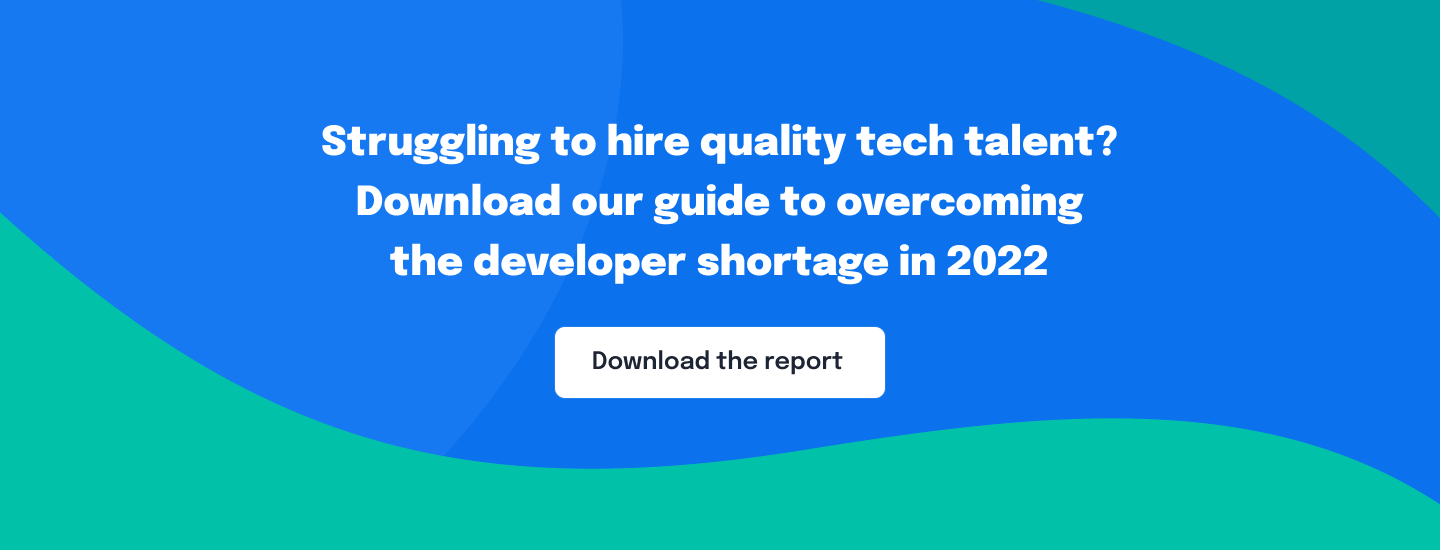A study at Harvard Business School revealed that the 3% of their MBA graduates who had clearly defined goals ended up earning ten times more than the remaining 97% — combined. In technical processes, such as software engineering, goal setting in the form of key performance indicators (KPIs) is vital if your development team is to achieve their set objectives.
The right software engineering metrics will help you evaluate the efficiency and give you meaningful insights essential in driving improvements. Setting KPIs is especially helpful if you collaborate with a remote team or outsource the development project. Additionally, using fixed metrics to track the team’s or developer’s performance helps to reduce micromanagement.
In this article, we will discuss the various KPIs for software development and their business value.
Table of Contents
Why are software developer performance metrics important in software development?
KPIs play a pivotal role in the software development life cycle. Here are some of the benefits of setting clear KPIs before beginning the process:
- They allow project managers, especially those working with Agile methodology, to identify, prioritize, track, and communicate any issues and potential areas of improvement for better team results. These KPIs are tracked in various productivity apps.
- They also keep stakeholders up to speed on the status of software development projects, better manage their workflow, and forecast the rate for future development.
- They reduce development costs as you won’t need extra rounds of edits or additional management.
In the end, setting KPIs increases return on investment (ROI) as it improves overall team/developer performance.
Best KPIs to measure efficiency in software development
Now that you are well-versed with KPIs for software developers and their crucial role in the programming process, we focus our attention on the best. They can be classified into four main categories: developer productivity, software performance metrics, defects metrics, and usability and UX metrics.
Developer productivity
Important KPIs falling into this category directly relate to the team’s efficiency in the software development process. They give you an idea of how much time and work the developers invest in the software project. To assess these KPIs, you may leverage time tracking software to keep tabs on the time dedicated to specific tasks and get a clear picture of overall developer productivity.
Velocity
It refers to the amount of work the development team can finish in a single sprint. Usually, the higher the velocity, the greater the team’s functionality. Therefore, it enables you to estimate your team’s level of productivity.
Team velocity can be measured by the number of tasks completed, ideal days, or story points — this last one being the most common unit. It is paramount to note that you will need about three sprints before you get an overview of the average development team velocity. While the metric is a useful measure of the team’s output, it does not highlight individual performances or the product’s level of customer satisfaction.
Sprint burnout
Sprint burnout is a more specific metric that evaluates the actual amount of work done in a single sprint or iteration. It provides more insight than velocity, which is an estimate calculated from multiple averages.
Release burnout
This KPI quantifies release progress. It guides software teams in managing product release, helping them assess whether they are ahead of schedule, on time, or lagging. It is a useful metric for updating enthusiastic customers of early or late releases.
Cycle time
Cycle time refers to the amount of time spent on a particular task. It is used to gauge the efficiency of the software development process. In addition, cycle time helps you estimate how long it will take your software team to finish future tasks.
Code coverage
It is a measure of code quality that encourages continuous delivery and test-driven development. It determines how much of the source code executes during the testing process — the higher the code coverage, the better the developmental progress. However, it is rarely 100% as some code will not execute due to undetected bugs.
Code stability
Code stability measures how minor changes in the product could potentially harm the business goals or software. Ideally, changing a few lines of code should not affect the whole application. Code stability can be thought of in terms of the percentage of deployed code that results in downtime.
Code simplicity
Code simplicity is another essential software development KPI. It can be quantified in several ways. For instance, there is cyclomatic complexity, which is the number of standalone paths you should code. In general, simple code is easily tested and maintained.
Code churn
This metric measures code stability and refers to the frequency of code changes. If the code is developed in such a way that it has to be rewritten every time to accommodate new features, then it’s high maintenance and high risk.
Software performance metrics
These are measurements and parameters determined during the software quality assurance process. Software performance metrics allow assessment and prioritization of problems within software development projects. They come in handy for:
- management
- debugging
- performance
- estimating costs
Throughput
Throughput is similar to velocity but more granular. It measures the number of features, tasks, bugs, and other activities completed during a certain period. It enables the project management team to evaluate how team members are spending their time frame as well as their workload.
Response time
This refers to the time lapse between when a request is sent to the server and when the last byte is received from the server.
Reliability
This performance metric refers to the likelihood that the software will produce the expected output at any given period of time. It is enhanced by features designed to avoid, detect, and repair software faults. A reliable software program will not continue to deliver erroneous results. Instead, it should detect and attempt to correct it, or, at least, isolate and report it. Reliability is linked to the mean time between failures (MTBF) using the formula: reliability = exp^(-T/MTBF).
Availability
This refers to the probability that the software is operational when needed. In other words, it is the amount of time that the software is functional, expressed as a percentage of the total time it should be operating. High-end availability features allow the software to remain operational even amid faults. They usually isolate the malfunctioning part and continue operating at a reduced capacity. On the other hand, less capable systems may crash and become incapacitated.
Serviceability
Otherwise known as maintainability, this refers to the ease and speed with which a software system can be serviced or repaired. It is paramount to note that serviceability and availability are inversely proportional. If the time for the former decreases, the latter increases. Serviceability, as a software development metric, factors in the diagnosis methodology when issues arise. For instance, some software systems are programmed to dial the service center automatically when there is a fault. The idea of the metric is to ensure the right repair efforts with as minimal disruption to normal services as possible.
Defect metrics
Software defects rank among some of a developer’s prime headaches as they cause deviation between what is expected and what is delivered. Therefore, the software tester needs to track and eliminate as many defects as possible. In an attempt to meet the high software quality demands, developers rely on a set of metrics for evaluating their efforts when dealing with discrepancies and errors. These are outlined below.
Code defect detection percentage
Also referred to as code defect detection efficiency, it measures the testing team’s efficiency. It is calculated as a ratio of the number of defects discovered before the software release and the total number of defects (including those found by customers after release). The formula for the defect detection percentage (DDP) is highlighted below.
DDP = [(Number of defects found before software release)/(Number of defects from internal testing + those found by customers after release)] x 100.
Vulnerability
Vulnerability is a performance metric that measures the extent of weaknesses in a software system prone to exploitation by a threat actor to access beyond privilege boundaries or perform unauthorized actions. The higher the vulnerability, the more SaaS security concerns.
Actual security incidents
This metric refers to the number of attempts to gain unauthorized access, disclosure, use modification, or information destruction in a software system. Security incidents can result in compromised user accounts, denial of service, theft, etc. It is an essential metric as it helps you establish the extent to which your software program is secure and offers potential mitigation measures.
Mean time to detect defects
Mean time to detect defects (MTTD) refers to the average time it takes to find a system’s software malfunction. In other words, it is the time between when an issue occurs and when the DevOps team detects it. It is paramount for software developers to strive to reduce its value as a longer MTTD may translate to a longer downtime, which, in turn, harms other business parameters such as customer satisfaction.
Mean time to repair
Mean time to repair (MTTR) is another crucial software KPI. It refers to the time interval that elapses between the discovery of a security breach and the deployment of a working remedy. A lower MTTR value implies that the development team’s performance is gradually becoming more competent in fixing software security issues such as bugs.
Browse 500+ Dev Teams Available for Hire
Usability and UX metrics
These are a set of metrics for software development crucial for evaluating the end-user’s satisfaction with the final product. While they are difficult metrics to assess due to their subjective nature and the dependence on the willingness of customers to engage, they offer powerful insights on whether the software is meeting expectations or not.
Net promoter score (NPS)
This refers to a customer’s willingness to recommend a software product or service to others. It helps measure the loyalty levels and end-user satisfaction, which is key for building long-term relationships. The value for NPS ranges between -100 and +100, and this data can be efficiently gathered using NPS survey tools.
Customer Satisfaction Score (CSAT)
This software development KPI is used to assess the level of the end-user’s satisfaction. The customer rates the software on a scale of 1 to 5 based on their user experience. It is quite easy to measure, however, a satisfaction survey needs to be sent to users. The assessments provide an overview of a client’s perception of the software, allowing you to identify and rectify potential issues.
Customer Effort Score (CES)
This is yet another usability and end-user experience metric that assesses how easily a customer interacts with your business through the software to complete a transaction, lodge a support issue, etc. To optimize the end-user experience, businesses leverage the Customer Effort Score calculation as a usability metric to evaluate the ease with which customers interact with their software for tasks such as completing transactions or lodging support issues. The CES value is on a scale of 1 to 7.
KPIs and tips to avoiding micromanagement
Setting KPIs and trying to meet them all puts additional pressure on a software development team. Micromanaging your coders may create a hostile environment, which is not conducive to team growth. The following tips may help keep you from overstepping.
- Minimize your physical presence during the development process
- Manage key performance indicators instead of individual tasks
- Trust your team
- Encourage your developers to make independent decisions
- Regularly give your team members more responsibility than you are comfortable with
Wrap up
KPIs for software development are pivotal in the entire programming process because they help managers assess and prioritize objectives and team goals. They can be classified into four categories, namely developer’s team productivity, software performance, defect and usability, and user experience metrics. The categories are based on the metric’s particular area of focus, and each gives essential insight into the software project’s overall status. It is key for all stakeholders to be well-versed with the various KPIs, their applications, and how they are calculated.










